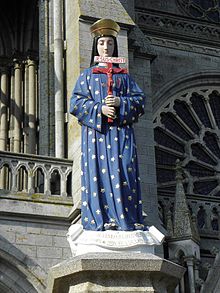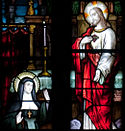
A Marian apparition is a reported supernatural appearance by Mary the mother of Jesus, or a series of related such appearances during a period of time.
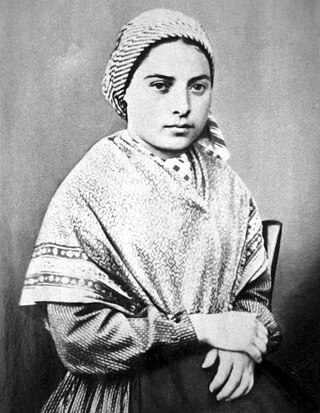
Bernadette Soubirous, also known as Bernadette of Lourdes, was the firstborn daughter of a miller from Lourdes, in the department of Hautes-Pyrénées in France, and is best known for experiencing apparitions of a "young lady" who asked for a chapel to be built at the nearby cave-grotto. These apparitions occurred between 11 February and 16 July 1858, and the young lady who appeared to her identified herself as the "Immaculate Conception".

Our Lady of Fátima is a Catholic title of Mary, mother of Jesus, based on the Marian apparitions reported in 1917 by three shepherd children at the Cova da Iria in Fátima, Portugal. The three children were Lúcia dos Santos and her cousins Francisco and Jacinta Marto. José Alves Correia da Silva, Bishop of Leiria, declared the events worthy of belief on 13 October 1930.

The Missionary Oblates of Mary Immaculate (OMI) is a missionary religious congregation in the Catholic Church. It was founded on January 25, 1816, by Eugène de Mazenod, a French priest later recognized as a Catholic saint. The congregation was given recognition by Pope Leo XII on February 17, 1826. As of January 2020, the congregation was composed of 3,631 priests and lay brothers usually living in community. Their traditional salutation is Laudetur Iesus Christus, to which the response is Et Maria Immaculata. Members use the post-nominal letters, "OMI".

The Sanctuary of Our Lady of Lourdes is a Catholic Marian shrine and pilgrimage site dedicated to Our Lady of Lourdes in the town of Lourdes, Hautes-Pyrénées, France. The sanctuary includes several religious buildings and monuments around the grotto of Massabielle, the place where the events of the Lourdes apparitions occurred in 1858, among them are three basilicas, the Basilica of Our Lady of the Immaculate Conception, the Rosary Basilica and the Basilica of St. Pius X, respectively known as the upper, lower and underground basilica.

Francisco de Jesus Marto and Jacinta de Jesus Marto were siblings from Aljustrel, a small hamlet near Fátima, Portugal, who, with their cousin Lúcia dos Santos (1907–2005), reportedly witnessed three apparitions of the Angel of Peace in 1916, and several apparitions of the Blessed Virgin Mary at Cova da Iria in 1917. The title Our Lady of Fátima was given to the Virgin Mary as a result, and the Sanctuary of Fátima became a major centre of world Christian pilgrimage.
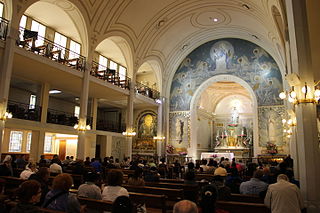
The Miraculous Medal, also known as the Medal of Our Lady of Graces, is a devotional medal, the design of which was originated by Catherine Labouré following her apparitions of the Blessed Virgin Mary in the Chapel of Our Lady of the Miraculous Medal of Paris, France.
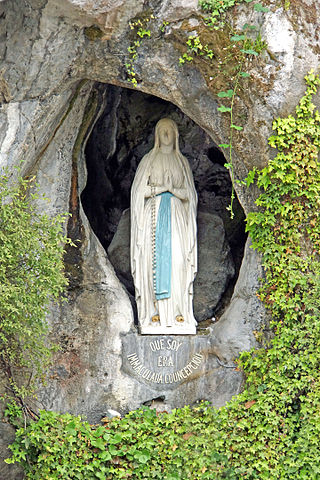
Our Lady of Lourdes is a title of the Virgin Mary. She is venerated under this title by the Roman Catholic Church due to her apparitions that occurred in Lourdes, France. The first apparition of 11 February 1858, of which Bernadette Soubirous told her mother that a "Lady" spoke to her in the cave of Massabielle while she was gathering firewood with her sister and a friend. Similar apparitions of the "Lady" were reported on 18 occasions that year, until the climax revelation in which she introduced herself as: "the Immaculate Conception". On 18 January 1862, the local Bishop of Tarbes Bertrand-Sévère Laurence endorsed the veneration of the Blessed Virgin Mary in Lourdes.

The Basilica of Notre-Dame de Fourvière is a minor basilica in Lyon, France. It was built with private funds between 1872 and 1896 in a dominant position overlooking the city. The site it occupies was once the Roman forum of Trajan, the forum vetus, thus its name.

The National Shrine of Our Lady of Champion, formerly dedicated as the Shrine of Our Lady of Good Help, is a Catholic shrine to Mary, mother of God located within the Diocese of Green Bay in the United States. The chapel is in the Champion section of Green Bay, about 16 miles (26 km) northeast of downtown Green Bay proper. It stands on the site of the reported apparition of Mary to a Belgian-born woman, Adele Brise, in 1859.
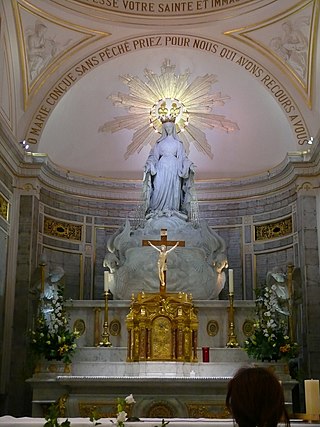
The Chapel of Graces of the Miraculous Virgin or informally the Chapel of Our Lady of the Miraculous Medal, is a Marian shrine located in Paris, France.
The Sanctuary of Our Lady of Bechouat, also spelled Beshouat or Beshwat, is a Marian shrine in the village of Bechouat in the Beqaa Valley of Lebanon.

Pontmain is a commune in the Mayenne department in north-western France.

The Lourdes apparitions are several Marian apparitions reported in 1858 by Bernadette Soubirous, the 14-year-old daughter of a miller, in the town of Lourdes in Southern France.

Our Lady of Kibeho, also known as Our Lady of Sorrows of Kibeho, is a Catholic title of the Mary, mother of Jesus, based on the Marian apparitions reported in the 1980s by several adolescents in Kibeho, south-western Rwanda. The young visionaries were Alphonsine Mumureke, Nathalie Mukamazimpaka and Marie Claire Mukangango.

Located at 6, rue Notre-Dame-des-Victoires, in the 2nd arrondissement of Paris, The Basilica of Notre-Dame-des-Victoires is one of ten minor basilicas located in the Île-de-France region of France. It was begun as an Abbey church, and constructed between 1629 and 1740 in the French classical style. Its name was given by King Louis XIII, who dedicated it to his victory over the Protestants at La Rochelle in 1628 during the French Wars of Religion. Notre-Dame-des-Victoires is famous for the ex voto offerings left there by the faithful. Over 37,000 devotional plaques, silver and gold hearts, as well as military decorations, have been left at the basilica. The closest Métro station is 'Bourse'.

Saint-Étienne-le-Laus is a commune in the Hautes-Alpes department in southeastern France.

Our Lady of Laus or Refuge of Sinners denotes Marian apparitions that took place between 1664 and 1718 in Saint-Étienne-le-Laus, France, to Benoîte Rencurel, a young shepherdess. The apparitions were approved by the Holy See on 5 May 2008. Pope Pius IX granted a Canonical Coronation to her marble image on 23 May 1855.

Our Lady of Beauraing is the title of 32 Marian apparitions reported in Beauraing, Belgium, between November 1932 and January 1933 by five children whose ages ranged between 9 and 15. For several years after the apparitions, pilgrims flocked to the small town of Beauraing, province of Namur (Belgium), and many cures were claimed. She is celebrated under this title on 29 November.
